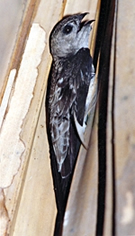Swift

Swift (batasi) any of about 100 species of small birds, usually dark brown or sooty with some areas of white or gray; long, scythe-like wings and small feet of the family Apodidae, order Apodiformes. Swiftlets are another swift-like cave-dwelling bird species belong to the same family. Worldwide there are 28 swiftlets, occurring in the Orient and Australasia. Their nests are made of plant material consolidated with copious saliva and are the basis of bird's-nest soup. They spend much of their time flying fast, catching insects with their small wide mouths. Another bird superficially resembling swifts, with long erectile crests, is tree swift which belongs to family Hemiprocnidae. Worldwide there are 4 Australasian and Oriental tree-swifts, which unlike true swifts spend much of the time perching in trees. Bangladesh has one species of migratory swift and 7 species of resident swifts of which one is a tree-swift (Table).
Swifts, with their narrow swept-back wings, have a well-deserved reputation for being among the fastest flying birds. Some of the swift species such as Pygmy Palm Swift Micropanyptila furcata of Venezuela, weigh less than 6 gm. All swifts pursue and capture their food, mostly insects, on the wing and stay aloft throughout the day, perching only at their overnight roosts. Some swifts regularly spend the night on the wing during the breeding season. They feed mainly on swarming insects such as termites, mayflies or aphids, as well as winged ants, wasps, and bees. Some swifts are migratory in habit.
The salivary glands of the swifts enlarge during the breeding season to produce a sticky material, which in some species is used to glue together small sticks to form the nest and also to attach it to the vertical wall of a hollow-tree nesting site. The saliva makes up the bulk of the nest. These nests are considered as the main ingredient of bird's nest soup.
| Family | Scientific name | English name |
| Apodidae | Apus affinis | House Swift |
| Collocalia brevirostris | Himalayan Swiftlet | |
| Cypsiurus balasiensis | Asian Palm Swift | |
| Hirundapus cochinchinensis | Silver-backed Needletail | |
| Tachymarptis melba | Alpine Swift | |
| Hemiprocnidae | Zoonavena sylvatica | White-rumped Spinetail |
| Migratory | ||
| Hemiprocne longipennis | Crested Treeswift | |
| Apodidae | Apus pacificus | Fork-tailed Swift |
Some cave swiftlets can nest and roost in total darkness deep in caves, sometimes more than a kilometre from any light. These birds make a series of audible clicks or rattle calls, and the returning echoes enable them to navigate within a cave and locate their own nest or roost site. Non-echolocating swiftlets nest in the twilight zone and near the entrance of caves where there is still sufficient light for visual flight. Both sexes participate in nest building, incubation, and provisioning of the chicks. For species that nest in colonies there often is much social activity in the form of grouped flights and vocalizing. Their calls vary, from short sharp chips to long-drawn-out buzzy screes or screams. [Md Anwarul Islam]
